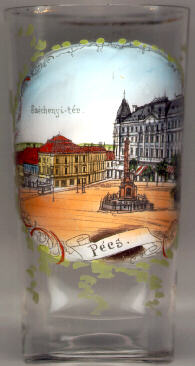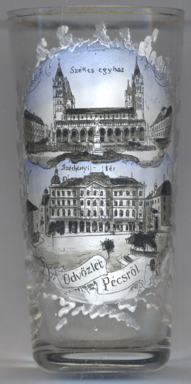

|
| MAGYARORSZÁG | HUNGARY |
| megye: Baranya |
The earliest traces of settlements in the area of the city of Pécs date back to the late Stone Age. A Celtic village of the 5th century BC was superseded by the Roman village of Sopianae which became the seat of the administration of the Roman partial province of Pannonia Valeria in the 3rd century AD. In the 9th century AD we find the name Quinquae Basilicae demonstrating the existence of five christian churches. From this name the German name of the town (Fünfkirchen) is derived. King Stephen I of Hungary (St. Stephen) founded the diocese of Pécs in 1009. The first university of Hungary was founded here in 1367 by King Lajos (Louis) I. During the years of the Turkish rule in Hungary (1526–1699) Pécs was the seat of a military governor. After the expulsion of the Turks many German settlers (the Danube Swabians) came into the country. In 1780 the citizens of Pécs were freed from their feudal duties to the bishop. During the 19th century the city flourished due to the coal mines in the nearby Mecsek mountains. The university was reestablished in the 20th century. Pécs is the seat of Baranya County. The early Christian necropolis of Pécs was listed as a World Heritage site by UNESCO in 2000 (see list of other World Heritage sites depictedon glasses of this collection). Together with Essen (Germany) and Istanbul (Turkey), Pécs was selected to be European Capital of Culture for 2010.
 The centre of the old town is the square
The centre of the old town is the square
 Széchenyi tér, named after
Count István Széchenyi (1791–1860), an important Hungarian statesman and reform politician.
Széchenyi tér, named after
Count István Széchenyi (1791–1860), an important Hungarian statesman and reform politician.
The  Trinity Column (Szentháromság szobor) [centre]
was originally erected after the years of the plague in 1713 by the sculptor András Berchardt.
It was replaced in 1750 by a new work by András Merchardt which stood
on this place for 150 years. Since this column had deteriorated by the end of the 19th century,
it was replaced by a copy made by György Kiss in 1908.
Trinity Column (Szentháromság szobor) [centre]
was originally erected after the years of the plague in 1713 by the sculptor András Berchardt.
It was replaced in 1750 by a new work by András Merchardt which stood
on this place for 150 years. Since this column had deteriorated by the end of the 19th century,
it was replaced by a copy made by György Kiss in 1908.
The  former Pécs Savings Bank [back right]
was built in 1898 in eclectic style. On its ground floor it also contained the popular 'Royal Coffee-House'.
From 1950 it was used as seat of the Baranya County Council. Today it used as an office building.
former Pécs Savings Bank [back right]
was built in 1898 in eclectic style. On its ground floor it also contained the popular 'Royal Coffee-House'.
From 1950 it was used as seat of the Baranya County Council. Today it used as an office building.
 The
The  Elephant block [back left]
is a group of houses in Baroque, Eclectic, Romantic and Neo-Classicist style. The name 'Elephant block' was given
to it after its recent restoration.
Elephant block [back left]
is a group of houses in Baroque, Eclectic, Romantic and Neo-Classicist style. The name 'Elephant block' was given
to it after its recent restoration.
The foundations of the  cathedral of St. Peter and Paul [right, no. 3474: top picture]
go back to the Roman period, around the 4th century. It is believed that at this site an early Christian church existed,
which, between the 8th and 9th centuries, was enlarged towards the western end. At the time of King Stephen I
(b. 969, d. 1038) that original church became the substructure of a new church. The two western towers of
the present church seem to date from that period. The Romanesque basilica was started after a large fire had mstly destroyed
the older church. During the Middle Ages two further towers were added. The church fell into decay during the period of the
Ottoman rule in Hungary (1543–1686), but was restored in various styles thereafter. A remodelling in Classicist style
was made in 1807. The church's present appearance was shaped finally in 1882–1891 when it was remodelled in
Neo-Romanesque style by the Vienna architect Friedrich von Schmidt. In 1991 the cathedral
obtained the status of a 'Basilica minor'.
cathedral of St. Peter and Paul [right, no. 3474: top picture]
go back to the Roman period, around the 4th century. It is believed that at this site an early Christian church existed,
which, between the 8th and 9th centuries, was enlarged towards the western end. At the time of King Stephen I
(b. 969, d. 1038) that original church became the substructure of a new church. The two western towers of
the present church seem to date from that period. The Romanesque basilica was started after a large fire had mstly destroyed
the older church. During the Middle Ages two further towers were added. The church fell into decay during the period of the
Ottoman rule in Hungary (1543–1686), but was restored in various styles thereafter. A remodelling in Classicist style
was made in 1807. The church's present appearance was shaped finally in 1882–1891 when it was remodelled in
Neo-Romanesque style by the Vienna architect Friedrich von Schmidt. In 1991 the cathedral
obtained the status of a 'Basilica minor'.
(see also list of other basilicae minores depicted on glasses of this collection)
The  monument for bishop Ignác Szepesy [right, no. 3474: top picture, foreground]
is located in Dóm tér (Cathedral Square) in front of the southern façade of the church. Szepesy
(name als spelled Szepessy) was
bishop of Transilvania (seat in Alba Iulia, the Gyulaféhérvár) from 1820 until 1827 and bishop
of Pécs from 1828 until 1838. The monument was created in 1893 by the sculptor
György Kiss from Pécs.
monument for bishop Ignác Szepesy [right, no. 3474: top picture, foreground]
is located in Dóm tér (Cathedral Square) in front of the southern façade of the church. Szepesy
(name als spelled Szepessy) was
bishop of Transilvania (seat in Alba Iulia, the Gyulaféhérvár) from 1820 until 1827 and bishop
of Pécs from 1828 until 1838. The monument was created in 1893 by the sculptor
György Kiss from Pécs.
[https://de.wikipedia.org/wiki/Kathedrale_St._Peter_und_Paul_(Pécs),
https://de.wikipedia.org/wiki/Liste_der_römisch-katholischen_Bischöfe_von_Siebenbürgen,
https://de.wikipedia.org/wiki/Erzbistum_Alba_Iulia,
http://www.iranypecs.hu/en/info/attractions/cathedralandbishophric/statue-of-ignac-szepesy.html,
http://www.catholic-hierarchy.org/bishop/bszdn.html]
![[scale]](lineal.jpg)